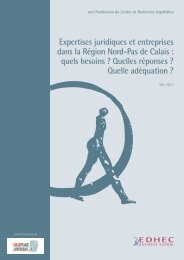Reactions to the EDHEC Study - Faculty and Research
Reactions to the EDHEC Study - Faculty and Research
Reactions to the EDHEC Study - Faculty and Research
You also want an ePaper? Increase the reach of your titles
YUMPU automatically turns print PDFs into web optimized ePapers that Google loves.
<strong>Reactions</strong> <strong>to</strong> <strong>the</strong> <strong>EDHEC</strong> <strong>Study</strong> “Optimal Design of Corporate Market Debt Programmes in <strong>the</strong> Presence of Interest-Rate <strong>and</strong> Inflation Risks” - May 20123. Survey Resultsdiversification is a fundamental building block, it is not <strong>the</strong> ultimate aim, <strong>and</strong> is insteada <strong>to</strong>ol used <strong>to</strong> pursue one specified objective that is subordinate <strong>to</strong> <strong>the</strong> inves<strong>to</strong>r’s overallgoal.Properly contextualising diversification requires identification of all sources of risk, <strong>and</strong> acoordination of all <strong>the</strong> means employed <strong>to</strong> manage <strong>the</strong>m. Thus, <strong>the</strong> scope of <strong>the</strong> pursui<strong>to</strong>f diversification can be segregated in<strong>to</strong> a performance seeking portfolio (PSP), whichhas <strong>the</strong> clearly defined goal of extracting available risk premia.11 - A recent Goldman Sachsresearch report identifiedlow levels of correlationbetween <strong>the</strong> Barclays USTIPS Index <strong>and</strong> several equityindices, broad bond indices,<strong>and</strong> a commodity index (<strong>the</strong>absence of an inflation-linkedcorporate bond index makesdirect comparison infeasible).It is fur<strong>the</strong>r important <strong>to</strong> recognise <strong>the</strong> limits of diversification. Diversification iscommonly misperceived as an ubiqui<strong>to</strong>us <strong>to</strong>ol for risk minimisation. As <strong>the</strong> marketdownturn in 2008 made evident, diversification fails <strong>to</strong> protect against a convergenceof correlation. Similarly, in <strong>the</strong> asset-liability context, diversification is inappropriate <strong>to</strong>hedge or immunise risk originating from liabilities. In accordance with an application of<strong>the</strong> fund-separation <strong>the</strong>orem, a liability-hedging portfolio (LHP), which abstains fromseeking returns or diversification, is <strong>the</strong> appropriate means <strong>to</strong> employ a dedicated method<strong>to</strong> hedging liabilities.fac<strong>to</strong>r affecting company cash flows.3.5 Questions Tailored <strong>to</strong> Inves<strong>to</strong>rsThe appropriate framework <strong>to</strong> analyse<strong>the</strong> applicability of inflation-linked bondsas hedges is one that eschews an asse<strong>to</strong>nlyperspective, <strong>and</strong> instead adopts anintegrated asset-liability managementperspective. While <strong>the</strong> primary focusof our study was how corporate issuerscould improve practices by adopting abroader analysis, similar considerationsmay also precipitate a modification ofan inves<strong>to</strong>r’s firm structure. For inves<strong>to</strong>rs,delineating a portfolio dedicated <strong>to</strong> hedgingliabilities – which, for many, may be asignificant departure from st<strong>and</strong>ardpractices – can be essential <strong>to</strong> immunising adifficult-<strong>to</strong>-manage risk fac<strong>to</strong>r such asinflation.a distinct objective compared <strong>to</strong> that of aliability-hedging portfolio. Inflation-linkedbonds have his<strong>to</strong>rically low correlation witho<strong>the</strong>r asset classes <strong>and</strong> could thus contribute<strong>to</strong> a portfolio’s improved risk-rewardprofile. 11 To address asset-allocationconsiderations we included a questionseeking recognition of <strong>the</strong> diversificationpotential of inflation-linked corporate bonds.It would be helpful <strong>to</strong> identify all attractiveattributes of this type of debt instrument,<strong>and</strong> whe<strong>the</strong>r it would be sought out forits contribution <strong>to</strong> risk-adjusted returngeneration, or for controlled risk matching,or both.Figure 9. Would you consider inflation-linked corporate bonds<strong>to</strong> be a useful addition <strong>to</strong> <strong>the</strong> strategic mix of asset classes?While inflation is clearly <strong>and</strong> measurablytied <strong>to</strong> many inves<strong>to</strong>rs’ liabilities, it isalso a prominent risk fac<strong>to</strong>r within <strong>the</strong>performance-seeking portfolio, which hasAn <strong>EDHEC</strong>-Risk Institute Publication17





